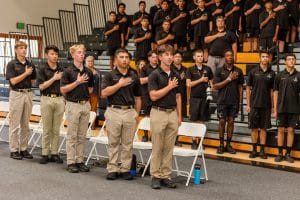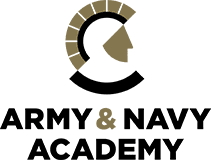
The answer is “absolutely yes.” But in addition to the Pacific Ocean being the Academy’s next-door neighbor, the answers to most queries can be obtained by answering one central question:
What makes the Army and Navy Academy different from other schools?
What follows are a few of the several points of difference between the college preparatory boarding school for middle- and high-school age boys located in Carlsbad, Calif. and other schools, both public and private. Many of those schools have some of the individual characteristics and resources that are being listed here – but not all of them.
The Army and Navy Academy is an all-boys school. Why is that a big difference? For one thing, there are not that many all-boys schools; in fact, fewer than 30 such high schools today in California. But more to the point: The Army and Navy Academy’s founders nearly 111 years ago knew intuitively what neuroscientists have discovered in recent years: Boys learn differently from girls. They need teachers, such as those at the Academy, who specialize in teaching boys. Also, boys need special learning environments where they can thrive as they develop academically, mentally, physically, and emotionally.
The structure of traditional co-educational schools tends to make these schools more responsive to how girls learn, which often results in boys being more likely to earn lower grades than girls; more likely to get into trouble; more likely to be attention-deficit and needing special education programs. This is perhaps one explanation for why, later on, fewer boys graduate from college or a university than girls. Recent statistics show that only four out of ten college graduates today are males.
The Academy’s core commitment to boys’ success goes much deeper than simply offering single-gender programs. To sum it up, the Academy believes that “greatness lies in every boy.” The Academy’s President, retired Army Maj. Gen. Arthur Bartell, explains how the school responds to its core belief:
“For boys to succeed, they must first believe in themselves. Our focus is to always keep boys at the center of our attention and leverage the structure that only we can provide through our 24/7, around-the-clock experience as a boarding school.”
To help its Cadets believe in themselves, the Academy recently introduced a three-part tagline that directly speaks to the Academy’s 7th– through 12th-grade Cadets that tells them to “Be Bold.” “Be Brilliant.” “Be You.”
Bartell added that the Academy emphasizes those imperatives to encourage Cadets to pursue independence and leadership in all that they do.
The Army and Navy Academy offers a rigorous academic curriculum. In addition to offering University of California A-G courses that meet that university’s admission requirements as well as several Advanced Placement (AP) courses, the Academy maintains a 11-to-1 classroom student-to-teacher ratio – far below what most, if not all public schools and many private schools have. Cadets receive a highly personalized level of attention from their teachers and coaches that enables them to excel.
The Academy is beginning its third year in offering its University of California-approved and STEM-based “Warrior Aviation Course.” It’s an elective for 9th– through 12th-grade Cadets interested earning college credits to major in aviation or aeronautics later in a college or university and pursue a career in aviation. Included are several aeronautically based STEM and courses as well ground school courses and flight simulators that prepare Cadets to take the Private Pilot written and flight proficiency exams upon completion of the four-year course.
The Army and Navy Academy provides complete range of academic and personal assistance to support the whole boy.
Unlike most public school students, Cadets have after-hours access to teachers for individual help as well as tutorials and other help beyond the classroom and into the early evening during Cadets’ mandatory study hours. Teachers, counselors, coaches, and administrators work as a team to provide a level of assistance that supports the Cadet’s whole well-being.
The Academy begins preparing Cadets for college outside the traditional classroom setting well before their senior year when they apply for colleges and universities.
Beginning at the Academy’s middle school level, 8th-grade Cadets take the ACT tests to assess their progress towards college readiness in reading, English, writing, and science.
Academy counselors work with senior Cadets to prepare them for the college application process and help sophomores and juniors research and prioritize colleges they want to attend.
Parents are kept well informed about their sons’ progress through regular and direct communications initiated by Academy staff and teachers.
As a military boarding school, the Army and Navy Academy builds leadership and character.
In the past, military boarding schools were thought to be schools that either groomed boys for careers in the military or were “institutions” where parents sent their troubled boys to “straighten up.” Nothing could be further from the truth at the Army and Navy Academy and other military boarding schools today.
The Academy boarding school’s environment instills into Cadets the principles of leadership and good character that go hand with academics while providing a 24/7 setting in which Cadets who live, study, and play together build life-long relationships.
The military theme and structure provide a consistency that boys need to develop essential life skills such as responsibility, accountability, discipline, self-confidence, and self-discipline. The military style of chain of command teaches Cadets how to follow and then lead; in keeping with the adage that in order to be an effective leader one must first know how to follow others.
The Army and Navy Academy uses the latest technology in – and out of — classrooms.
Just a couple examples of the technology tools the Academy uses to help students learn by interacting with teachers and other Cadets during and after the school day. Cadets in all grades use Chromebooks for quizzes, online homework, research, presentations, sharing ideas, and collaborating with other Cadets participating in Google Classroom activities and Google Slide presentations.
The Academy also uses Promethean interactive digital white boards in some classrooms to make its college preparatory curriculum in those classrooms more dynamic as well as to give Cadets who use the smart boards constructive peer interactions and group collaboration experiences.
Using technology in the Academy’s classrooms encourages peer coaching that carries over into other classroom activities. One teacher said that peer coaching, brought about by the use of technology “changes the style and tone of the classroom a lot.”
The Army and Navy Academy emphasizes leadership education and building good character.
The Academy has several resources beyond academics that carry out its mission to “educate, mentor, and develop good character and leadership in young men.” Cadets can serve in a wide variety of leadership positions through the Academy’s JROTC program, student government organizations, and a host of extra-curricular clubs.
Cadets’ mandatory participation in the JROTC program extends beyond the traditional JROTC parameters at other high schools. It includes the Academy’s year-long Officer Candidate Course that teaches advanced leadership skills to 11th-grade Cadets who will be assuming leadership positions the following school year. Each spring, Cadets are evaluated on a number of performance objectives through leadership and discipline assessments, physical fitness and appearance, written and oral exams, and testing their ability to lead Cadet formations, and assume responsibilities.
These emphases on leadership education as well as the personal character virtues of duty, loyalty, compassion, honor, integrity, courage, respect, and gratitude are rarely taught, much less emphasized in typical public school’s curricula. And, yet, character development has a direct impact on academic achievement since many of the principles taught apply in mastering academic subjects.
More important, though, these skills and personal virtues are necessary to achieve meaningful goals and real success throughout life.
Still have questions? For further information on the Army and Navy Academy, visit the website at https://www.armyandnavyacademy.org; e-mail at admission@armyandnavyacademy.org or phone at 888.762.2338.

Candace Heidenrich is the CEO of Aperture Advisory Associates, where she works with private secondary and higher education leaders to strengthen programs and practices. She founded Aperture in 2018 after more than a decade in a senior administrative role at a boarding school in California. Additionally, she held faculty and chair positions at private schools and colleges in Los Angeles and Ojai. Her background also includes director and executive level positions with start-ups and Fortune 500 corporations.
While earning her B.A. in Education and Humanities in the Lawrence Henry Gipson Scholar program, she studied abroad at Oxford before pursuing her master’s at the University of California, Santa Barbara. A frequent speaker at national conferences, she is a recognized thought leader and authority on enrollment management and marketing best practices.